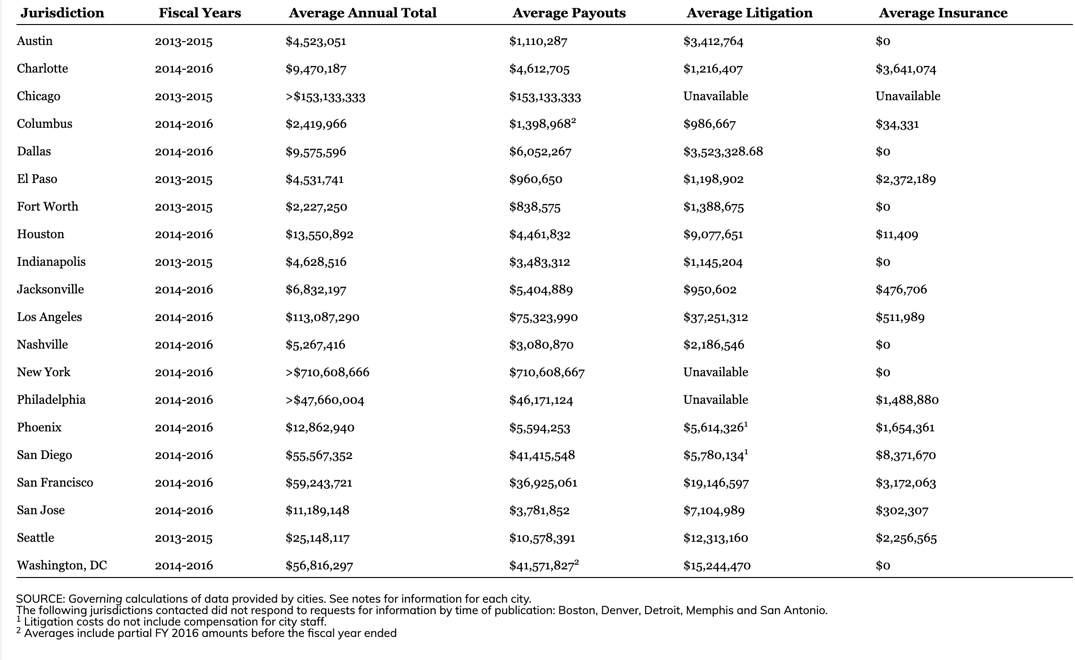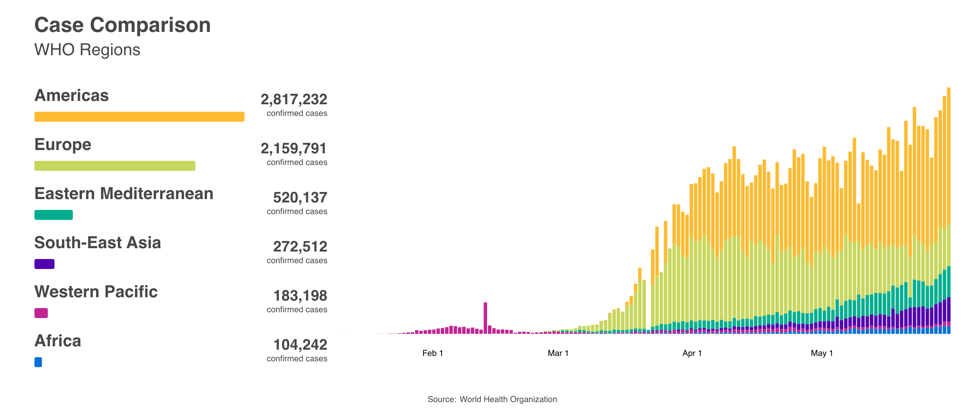 Covering COVID-19 is a daily Poynter briefing of story ideas about the coronavirus for journalists, written by senior faculty Al Tompkins. Sign up here to have it delivered to your inbox every weekday morning.
Covering COVID-19 is a daily Poynter briefing of story ideas about the coronavirus for journalists, written by senior faculty Al Tompkins. Sign up here to have it delivered to your inbox every weekday morning.
“Crisis” may be an overused word, but city and state governments will rightfully claim that word for the pinch that the COVID-19 pandemic put them in. And while city governments cut essential services and laid off workers, one place that they could save a ton of money is in the millions of dollars they pay out in police misconduct lawsuits.
These payments often go unreported because of confidentiality agreements, but the settlements show up somewhere in official government documents. You just have to look. And if the government won’t turn the data over, report that, too.
How much are we talking about?
WBBM-TV in Chicago found that Chicago taxpayers paid $20.3 million for police-involved lawsuits in just the first eight weeks of 2018. By the end of that year, Chicago paid out $113 million in police lawsuits.
In New York City, the metro government paid $229.8 million in lawsuit claims against the police department. Overall, the City of New York paid out $1 billion in various lawsuit claims in fiscal year 2018.
In 2015, The Wall Street Journal went after this story. It is long overdue for an update. Back then, the Journal found that video evidence was a huge factor in cities settling lawsuits fast and for big money. The 2015 story also found:
For most of the police departments surveyed by the Journal, the costliest claims were allegations of civil-rights violations and other misconduct, followed by payouts on car collisions involving the police. Misconduct cases were the costliest for New York, Chicago, Los Angeles, Philadelphia, Washington, Dallas and Baltimore. Car-crash cases were the most expensive for Houston, Phoenix and Miami-Dade, a county police department.
In 2016, Governing Magazine conducted a survey of the nation’s 20 largest cities and found that the millions in lawsuit payouts is only a fraction of the cost of the entire litigation.

From Governing data gathered in 2016. Data is for all lawsuits involving the cities. (Governing)
Will the protests hasten the end of COVID-19 precautions?
Epidemiologists are saying that within two weeks we should see a spike in COVID-19 cases because of the coast-to-coast street protests, where masks seemed more to protect against pepper spray and social distancing was the last thing on people’s minds.
Cornell Law School professor and media critic William A. Jacobson told Fox News, “Now that rioters and looters are gathering in large numbers, the media no longer cares about social distancing, because the media sympathizes with them.”
Well, I am not so sure about that. But it is not up to any of us to decide on our own that the pandemic is over. Cases and deaths were increasing, even before the street protests.

(World Health Organization)
The Johns Hopkins tracking data showed that some states are counting fewer new cases but in others, shown below in reddish tones, cases are rising. The greener the background, the bigger the downward trend of new cases in that state. The redder the background, the bigger the upward trend of new cases in that state. Click on the map to get state-by-state data.
Don’t throw away your stimulus debit card
Millions of households are getting prepaid debit cards instead of direct deposits as their stimulus payments. And because they come in an envelope marked “Money Network Cardholder Services,” and aren’t specifically labeled as being from the U.S. government, people are thinking they are junk mail and tossing them in the trash.
I know you have covered some version of this story before but it was the top business story on The Washington Post’s website Monday. A little news coverage would probably stop the confusion.
Refrigerator sales are up
OK, I didn’t see this one coming. ResearchAndMarkets.com, an international market research reports and data source, said the refrigerator industry has seen a 160% increase in sales since the COVID-19 lockdown.
Why? Because people bought so many groceries that they needed someplace new to store all of it. Another notion is that people are buying new appliances rather than allowing people into their homes to fix existing appliances (which seems a tad luxurious to me, but it is a consumer trend, according to the Association of Home Appliance Manufacturers).
Ramsey Bishar, owner of Big George’s Home Appliance Mart in Ann Arbor, has sold almost 500 freezers over the past several weeks versus annual sales typically totaling 200. Another 25 people are on a waiting list lasting five days to a week as the industry grapples with shortages because the outbreak is interrupting manufacturers. The company’s smart home department, including smart TVs and upgrades to WiFi systems, is up 35% year-over-year, too.
“As people work from home,” Bishar said, “they want a more reliable network.”
Bloomberg reported other appliances are selling well, too:
Sales from March 15 to April 11 rose for about 70% of the 88 subcategories for home and kitchen goods tracked by market researcher NPD Group. Some of the gains were just staggering, including electric pasta makers (462%), soda machines (283%), handheld cleaning devices (284%), water filtration machines (152%) and air purifiers (144%).
Also on the “hot” list are washing machines with sanitizing cycles, bathroom exhaust fans with “germ-killing” lights and motion-triggered faucets like you see in commercial bathrooms that may be catching on in homes.
Is there any reason to worry about this?
NPR ran a story Monday that raised my curiosity. It had to do with dress rental companies seeing a big drop in business and worrying about the future. I can understand a drop in business, as people are not going out to formal gatherings, or informal ones for that matter.
But is there any real worry that you might get sick from wearing a rented dress? If that’s true, won’t thrift stores be pretty much cooked? And wouldn’t all clothing stores need to ban trying on clothing?
At the moment, we do not have any scientific evidence that you can get sick from clothing that has been infected with COVID-19. There is a story that says viruses might be able to live on cardboard, but even then, the evidence is dubious.
What’s up with beef prices?
The U.S. Department of Agriculture is a bit mystified why COVID-19-era beef prices are so high and investigators are looking into allegations of price-fixing. Four meatpackers control about 85% of U.S. beef supplies. While the price you pay for beef has risen in the last month, the price that farmers get for the cattle they sell fell by 20%. Meat processing companies said factory shutdowns pinched supplies to grocery stores and, because they need fewer cattle, the selling price for farmers fell. Essentially, it is a supply-and-demand issue on both sides of the process with different results.
Beware of headlines that say, ‘X is up by X%’
You are going to be seeing a lot of this in June as retail sales, airline travel and hotel occupancy rates slowly begin to revive. But keep in mind that, for example, even a tiny number of passengers who board airlines could be a triple-figure percentage increase from April.
In a really smart New York Times Upshot essay, Neil Irwin warned that politicians will be using these percentages to claim the recovery has begun, without referencing the hole we are still in:
When something falls by 10% and then rises by 10%, it might seem as if it ends up back where it started. But that’s not how the math works.
A 10% drop from 100 to 90, followed by a 10 percent gain, would return it only to 99. With bigger swings, those effects become more striking. A 40% drop followed by a 40% gain would result in a quantity 16% below the starting point.
At even greater extremes, you end up with bonkers numbers like those in the air traffic example, in which a 96% drop followed by a 123% gain leaves you with a number that is still 91% below normal.
Irwin pointed out that the confusion may deepen further when we see second-quarter gross domestic product figures that tell us how the economy performed in April, May and June. We will be tempted to compare those figures to the first quarter, but that will have been before the full effects of the pandemic hit the U.S. So we may be in recovery mode by the end of June and be confronted by figures that make things seem worse than they are at that moment.
Then, assuming the recovery chugs along in the third quarter, we would see a whiplash GDP for July, August and September, a figure that would come out on Oct. 29, five days before the election.
As Irwin said, it very well might be the greatest ever quarterly GDP percentage increase. But we would have to ask, compared to what?
We’ll be back tomorrow with a new edition of Covering COVID-19. Sign up here to get it delivered right to your inbox.
Al Tompkins is senior faculty at Poynter. He can be reached at atompkins@poynter.org or on Twitter, @atompkins.








